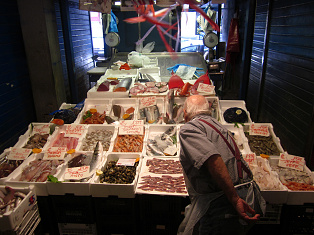 Rome food and meals are warm and hearty affairs
Rome food and meals are warm and hearty affairs
Whether one chooses to dine at a first-class restaurant, a no-nonsense osteria, or an unpretentious trattoria, Rome food recipes are simple yet their success dependent on seasonal, fresh ingredients. Rome food and meals are warm and hearty affairs, that consists of a primo pasta course or antipasto, fish or meat course, and contorno, salad or cooked vegetables. Most Rome food in restaurants, except for the most exclusive restaurants, goes with house wine, usually white wines. Dolce or desserts are not common with Rome food, although desserts made with sheep’s milk ricotta from local Lazio sheep are scrumptious. The summer is the best time to sample ice cream at the local gelatetrie.
Visitors who are not used to such lengthy meals, which can stretch for three hours, can skip the courses without causing offence. Whereas southern Italy is reputedly the country’s cooking heart, Rome food strongly sticks to its own culinary traditions, and look upon food from other regions, especially from other countries, with a little suspicion. As a result, Rome food is not strong in the international cuisine, with exceptions to Somalian, Eritrean, and Ethiopian cuisine offered by long-established communities in the Piazza Vittorio vicinity. On the other hand, Rome food offers variety to the experts and each borough of the city has its own favorite dish.
The Jewish society has influences the culinary traditions of the whole city, and is accountable for such delicacies as carciofi alla giudía, which is made of artichokes cooked in hot oil until crunchy and tender; and filetti di baccalá, which are salt cold fillets. Restaurants surrounding the Ghetto area serve up genuine Roman-Jewish cuisines and ambiance.
Fiestas and Rome food go hand-in-hand
The winding medieval streets of Trastevere, to the south of the Isola Tiberina, are packed with laid-back, affordable restaurants and pizzeria. The best fish dishes can be found here probably because of its location by the Ripa Grande port. East of the River Tiber, is Testaccio, famous for dishes such as oxtail braised in tomatoes, zest with pine nuts, cocoa and raisins, which is said to have began from the native butchers being paid in surplus meats.
Fiestas and Rome food go hand-in-hand, and the celebration of San Giovanni every 24th of June is a good justification for gluttony and the eating of snails prepared in marjoram, tomato, and Roman mint, sluiced down with a little traditional wine.
Pizzas are customarily thin and crispy in Rome, although the thicker Neapolitan assortment is gaining popularity in the city’s many pizzerie. The best international Rome flavors include spicy Ethiopian cuisine with vegetarian alternatives, and African cuisines at the Via Gaeta.
For visitors craving a cup of tea and dainty cakes in refined surroundings should go to the foot of the Spanish Steps, where one can find Babington with décor and prices that are spectacular.